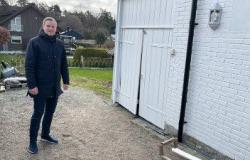When the police have to find out what has happened in fights and other violent incidents among young people, it turns out more and more often that the whole thing has been filmed.
The videos are quickly spread. Maybe first among friends, but soon “everyone” has seen them.
The police believe this can contribute to normalizing violence.
Film violence and vandalism
Last week, the police were called to a violent incident at Skodje in Ålesund. Three men in their 20s allegedly hit and kicked another. A total of four were involved in the violent incident.
Afterwards, videos of the fight have been shared on social media.
The police are investigating the case. The videos can be important for mapping who has done what, says Birgitte Øye at Nordre Sunnmøre police station.
– We have received several videos. Videos of, for example, vandalism that is carried out on a car, as well as of a violent incident. We have to go through video material to see if these can be linked to the violent incident.
Four men in their 20s were taken into custody after three of them attacked an elderly man. The video must be from the attack.
Four people are wanted after the incident in Skodje.
– They are charged with grievous bodily harm or complicity in this. We are also considering filing a case for damages when it comes to insulting one’s car.
– Contagion effect
The video from Sunnmøre is far from the only incident of violence among young people that is filmed and shared.
These are just some of the cases that NRK has previously discussed. The police fear that the sharing of such videos could create a contagion effect.
– It can help to normalize the violence. It can create an expectation in the youth environment that this is how it is, and that this is how you solve a problem. Some may do it to shock in order to get the most clicks.
That’s what Daniel Ludviksen says, section leader for intelligence and prevention in Møre and Romsdal police district. He also refers to social media accounts that share videos of unlimited violence.
Ludviksen tell them that they do not have statistics on how many people film and share incidents of violence, but that they have the impression that this is increasing.
Ludviksen believes it will be difficult to reduce the number of violent incidents among young people. Punishment is a reaction, but he emphasizes that it is also important to work preventively, to collaborate crosswise and to build relationships over time.
Photo: Øyvind Sandnes / NRK
– You get it right in the face
The 17-year-olds in Ålesund have also noticed the development. On most social media platforms, they have experienced seeing videos of violence or people making threats.
Some of the videos are from people they know, others are from unknown users elsewhere in the country or in the world.
– It’s quite a lot sometimes. You get it right in the face. Earlier today I picked up a video after only scrolling for 20 seconds on X. I feel that it is quite normal to see it now, says Ådne Fylling Holmdal.
Young people especially believe that those who are younger than them can be influenced when they see such things.
– Those who do not have such a clear picture of what is real, and get the impression, may think that violence is more common. Some may find it exciting and share it further, says Birger Bunes.
The 17-year-olds in Ålesund have all experienced seeing videos of violence on social media. They feel that it has become more common to record such videos.
Photo: Silje Steinnes Bjerknes / NRK
The four agree that the mobile phone is becoming an increasingly large part of everyday life, and that it can also lead to videos being spread more easily now than before.
– We have platforms that give us access to a lot, and with one key press it is forwarded, says Jenny Storlykken Sunde.
Josefine Uggedal Longva has the impression that there will also be more elections.
– When we were younger, we weren’t exposed to such things as much. But in recent years I feel it has been a lot. Also videos of animal cruelty. You don’t always get to know the back story, you only see what happens. Then those who are younger may think that it is okay, but it has consequences.
– New abuse
Daniel Ludviksen in the police emphasizes that it is a criminal offense to share videos of violent incidents.
In addition, the rape victims are exposed to a new assault by the videos being shared, says Ludviksen.
– It is quite offensive to have pictures and videos spread. Several people contact us and describe it as a heavy burden. And once it ends up on the internet, it is difficult to get rid of.
– More young people become criminals
According to the police, the statistics are clear. In Møre and Romsdal, they see a 40 percent increase in the number of young people who become criminals before they turn 18.
There are also several 14- and 15-year-olds who appear in the statistics.
– It is very serious. One thing is that they are young today, but it is crucial that we manage to stop it before they enter a criminal racetrack, says police chief in Møre og Romsdal, Ingar Bøen.
Police chief in Møre and Romsdal, Ingar Bøen, says that the police often go out and urge people not to share violent videos they receive. This seems to have had a good effect.
Photo: Mia Sofie Ytreberg / NRK
He emphasizes that there is a greater chance of continuing with crime in adulthood, when one is introduced to this at an early age. The police will work to reverse this.
– What is fundamental for us is that there is not just one owner of this problem. We must achieve good cooperation with the home, school, child welfare and Nav. We all have to pull together for this to be closed, says Bøen.
– It is important that we manage to stop it before it goes too far. Before they ruin their lives, says the police chief.
Tags: police fear sharing violent videos normalizes violence among young people
-






